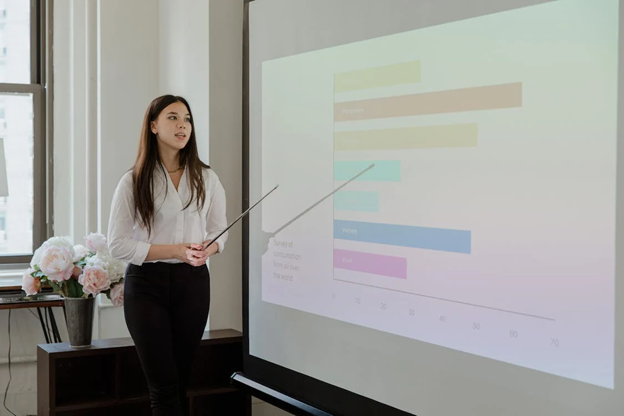How to Maximize the ROI of Live Language Training
What’s the best way to get value from workplace language training?
The key lies in a thoughtful, data-driven process: begin with needs assessment, set realistic goals, partner with the right language coach, iterate based on feedback, and maintain momentum over time.
Step-by-Step: Maximizing Return on Language Training
1. Conduct a Language Needs Assessment
Before investing, analyze which languages actually matter for your organization. This includes:
- Listing internal and external stakeholders who use multiple languages (clients, branches, cross-border teams).
- Assessing current proficiency across roles and departments.
- Prioritizing languages by business relevance (e.g. sales markets, customer support, supply chain).
- Estimating target proficiency levels (e.g. conversational, business-level, negotiation).
This step ensures you invest in the right scope of language training rather than overextending resources.
2. Choose the Right Language Coach or Provider
Select a provider who delivers live, instructor-led language coaching and training(virtual or onsite) rather than self-paced modules. Key criteria include:
- Demonstrated experience with corporate clients and measurable outcomes.
- Flexibility in delivery modes (virtual classroom, onsite, hybrid).
- Capability to tailor content (industry vocabulary, contextual role-play).
- Support for coaching and reinforcement outside sessions (e.g. micropractice, review sessions).
- Strong references and case studies of success.
A language coach who understands business context can accelerate learning and application.
3. Define Clear, Measurable Goals
Goals must align with business outcomes. Possible targets include:
- Improved customer satisfaction or reduced error rates in multilingual interactions.
- Faster onboarding or internal communication in multilingual teams.
- Reduced escalation or translation costs.
- Improved employee engagement or retention among multilingual staff.
Make goals SMART: Specific, Measurable, Achievable, Relevant, Time-bound.
4. Customize Training to Your Industry and Roles
A generic language curriculum often misses critical vocabulary and scenarios. Instead, work with your coach to:
- Incorporate terms specific to your industry (technical, legal, sales, operations).
- Design role-play or simulations reflecting typical workflows (client calls, team meetings, emails).
- Focus on relevant communication modes (listening, speaking, writing) in context.
This contextual relevance accelerates retention and real-world use.
5. Cultivate a Learning Culture
Language training thrives in a supportive environment. Encourage adoption by:
- Providing dedicated time (e.g. “language hours” or practice breaks).
- Recognizing and celebrating milestones or language achievements publicly.
- Offering optional micropractice or peer conversation groups.
- Encouraging managers to role-model using the language (simple greetings, phrases).
6. Promote On-the-Job Use and Practice
Language skills plateau unless used. Encourage real-world application by:
- Using the target language in meetings, email introductions or greetings, internal slack channels.
- Pairing learners with native or fluent peers for conversation buddies.
- Running “language minutes” at team meetings where someone uses a short phrase or leads in the target language.
- Tracking usage challenges, then iterating content to address those gaps.
7. Monitor Progress and Gather Feedback
Schedule regular check-ins with learners and stakeholders to:
- Assess progress using objective measures (pre/post tests, mock calls, recorded assessments).
- Collect qualitative feedback on content, pacing, and confidence.
- Identify obstacles (e.g. schedule conflicts, technology issues).
- Adapt the training plan promptly (e.g. adjust focus areas, group mixes).
8. Leverage Technology Appropriately
While live instruction is core, supporting tools help retention:
- Micropractice modules (5-10 minute drills) to reinforce vocabulary between classes.
- Recorded review sessions or pronunciation drills as supplemental resources.
- Interactive quiz apps or spaced-repetition platforms integrated with coaching content.
- Video calls with native speakers for conversational immersion.
Use technology to support, not replace, the role of the live instructor and coach.
9. Provide Ongoing and Advanced Training
Language skills fade without reinforcement. Maintain momentum through:
- Refresher workshops (e.g. quarterly or semiannual).
- Advanced modules targeting higher proficiency levels or specialized skills (e.g. negotiation, presentations).
- “Alumni” or peer learning groups to sustain engagement.
10. Measure ROI and Communicate Strategic Impact
Translating language training into business metrics builds credibility. Use the formula:
ROI = (Monetary Benefit – Cost of Program) ÷ Cost of Program
To do this:
- Estimate direct benefits: reduced translation costs, improved productivity, fewer errors.
- Estimate indirect benefits: higher customer satisfaction, retention, internal efficiency.
- Compare against total investment (instructor hours, materials, tools, management time).
Report outcomes to leadership—ideally tying to revenue, cost savings, or efficiency gains. SHRM recommends linking training metrics directly to business goals to justify investment. :contentReference[oaicite:0]{index=0}
Why This Approach Succeeds: The Underlying Rationale
Here are the reasons this method outperforms ad hoc language training:
| Traditional Approach | Strategic, Coach-Centered Approach |
|---|---|
| One-off courses, little follow-up | Sustained, scaffolded training with measurement |
| Generic content with low relevance | Customized content tied to roles and scenarios |
| Passive tools (self-study modules) | Live instruction plus reinforcement tools |
| No ROI tracking or business alignment | Data-driven metrics aligned with outcomes |
Communication challenges cost organizations significantly—especially across languages and media. Poor communication has been identified as a drag on team effectiveness and decision-making. Meanwhile, research shows that language training can deliver measurable business outcomes when tied to strategic goals.
How to Begin Implementing Workplace Language Trainingat Your Company
Here’s a simple plan for HR professionals, team leads, or business owners:
- Initiate a pilot: select a small team or department for a focused language training experiment.
- Apply this 10-step approach to the pilot, track all costs and benefits.
- Use pilot success metrics to build the business case for scaling across the organization.
- Integrate language training into ongoing learning and development strategy (e.g. for leadership, global teams).
- Continue iterating as you scale—monitor feedback, retention, and evolving business needs.
For assistance designing or scaling a language training program, engage Workplace Languages to help you build a tailored, scalable solution. Contact us to Request a Quote.
Frequently Asked Questions (FAQ)
1. How long does it take to see results from live language training?
You can often see improvements in confidence and basic communication within 8–12 weeks. Meaningful business outcomes—such as reduced errors or stronger client relationships—typically emerge after 6–12 months, depending on usage and reinforcement.
2. Can we use a mix of virtual and onsite training?
Yes. A hybrid model often delivers flexibility and accessibility, without sacrificing the interpersonal benefits of in-person sessions.
3. Is a language coach essential, or can internal trainers do it?
Internal trainers may lack specialized language and pedagogical expertise. A skilled language coach brings tested methods, consistency, and accountability, while coaching internal champions to support the program.
4. What metrics should I track?
Key metrics include pre/post proficiency tests, usage logs (e.g. conversations, email usage), qualitative feedback, error/translation cost changes, and any impact on customer satisfaction or efficiency.
5. How do we sustain momentum after the initial phase?
Sustain momentum through refresher workshops, advanced modules, peer language groups, and live coaching check-ins. Reinforcement tools and regular evaluation help prevent skill decay.
6. How do I convince leadership to invest in live language training?
Frame language training in terms of ROI: reduced costs, revenue potential, productivity gains. Use pilot results and tie outcomes to business goals (e.g. market expansion, client retention). SHRM emphasizes that linking training to hard metrics is critical for securing executive buy-in.




